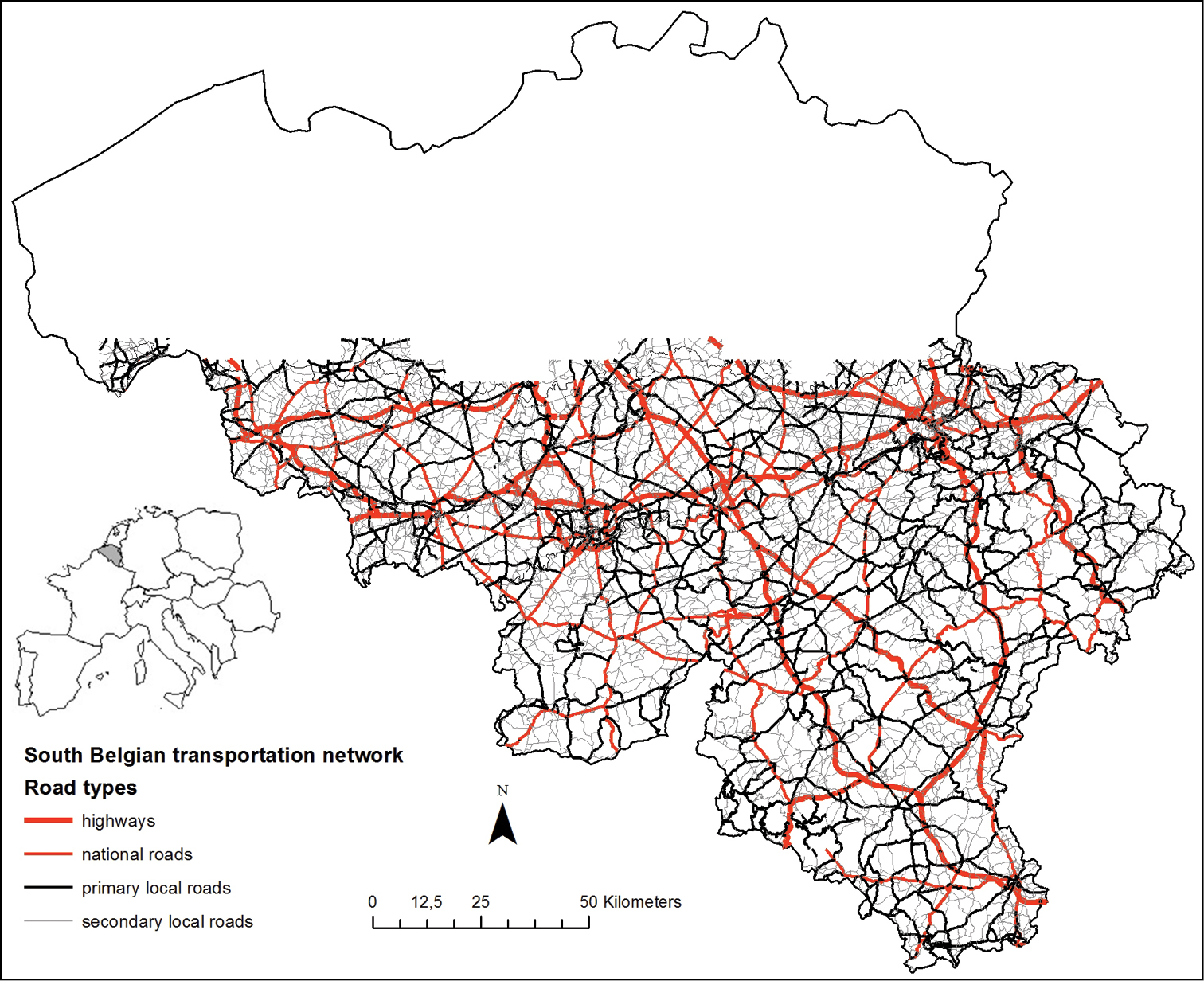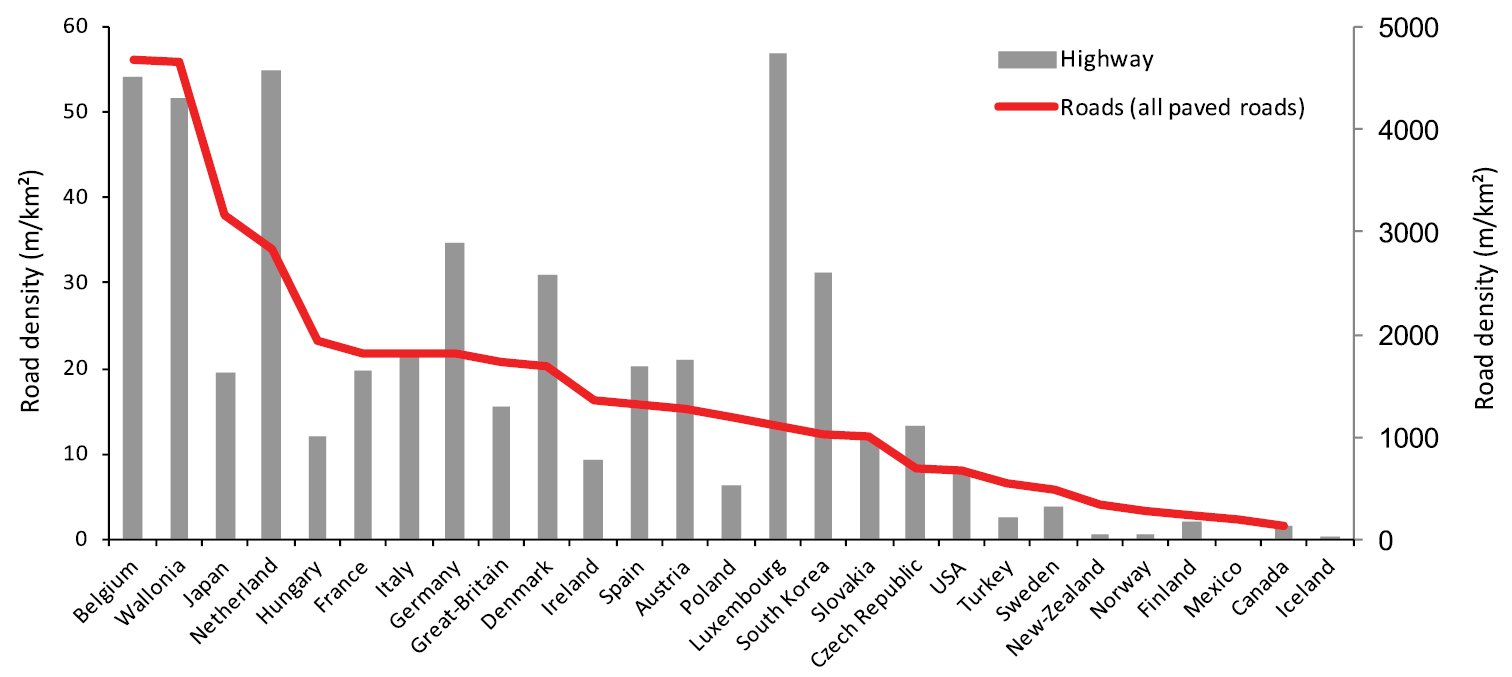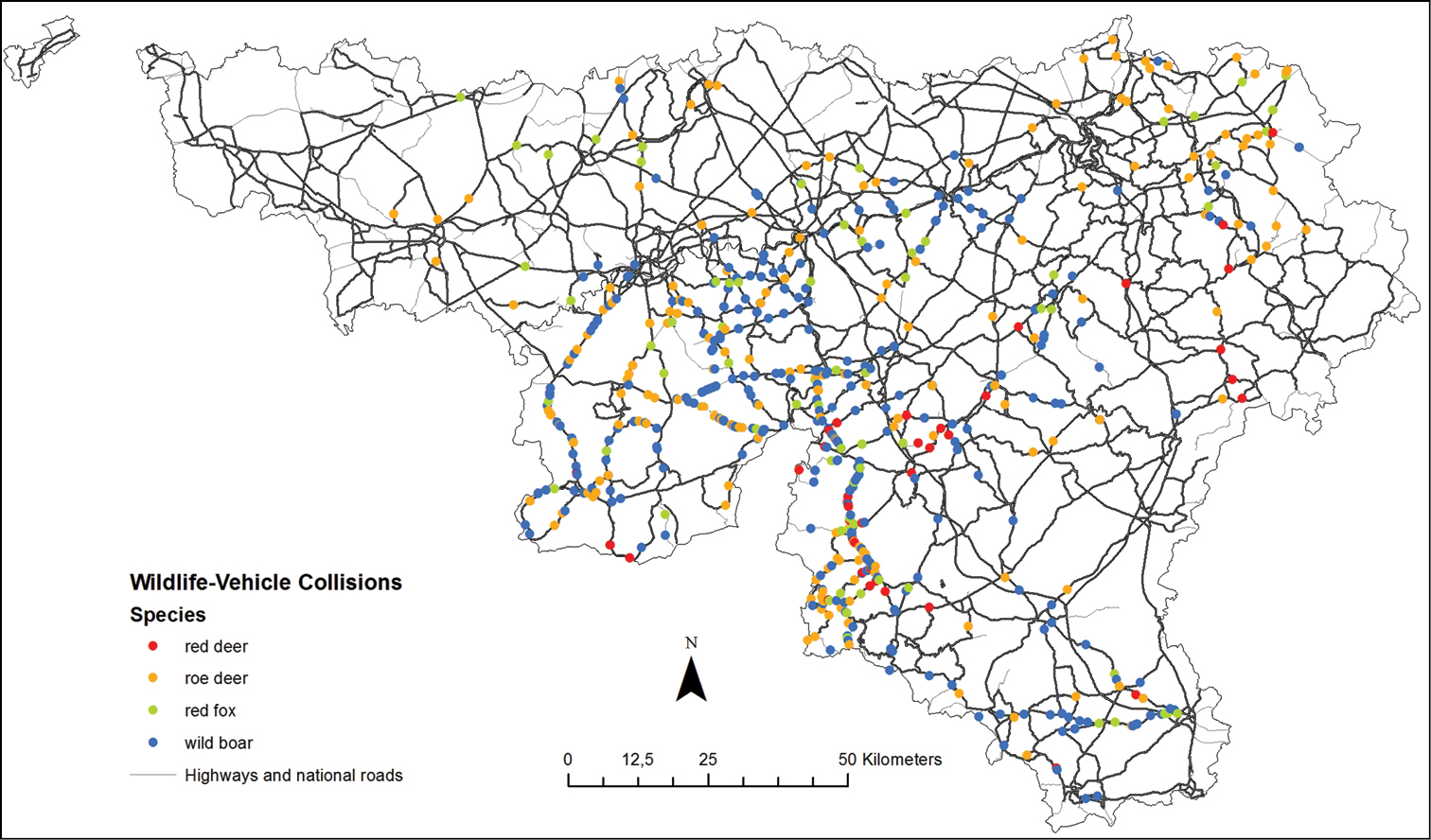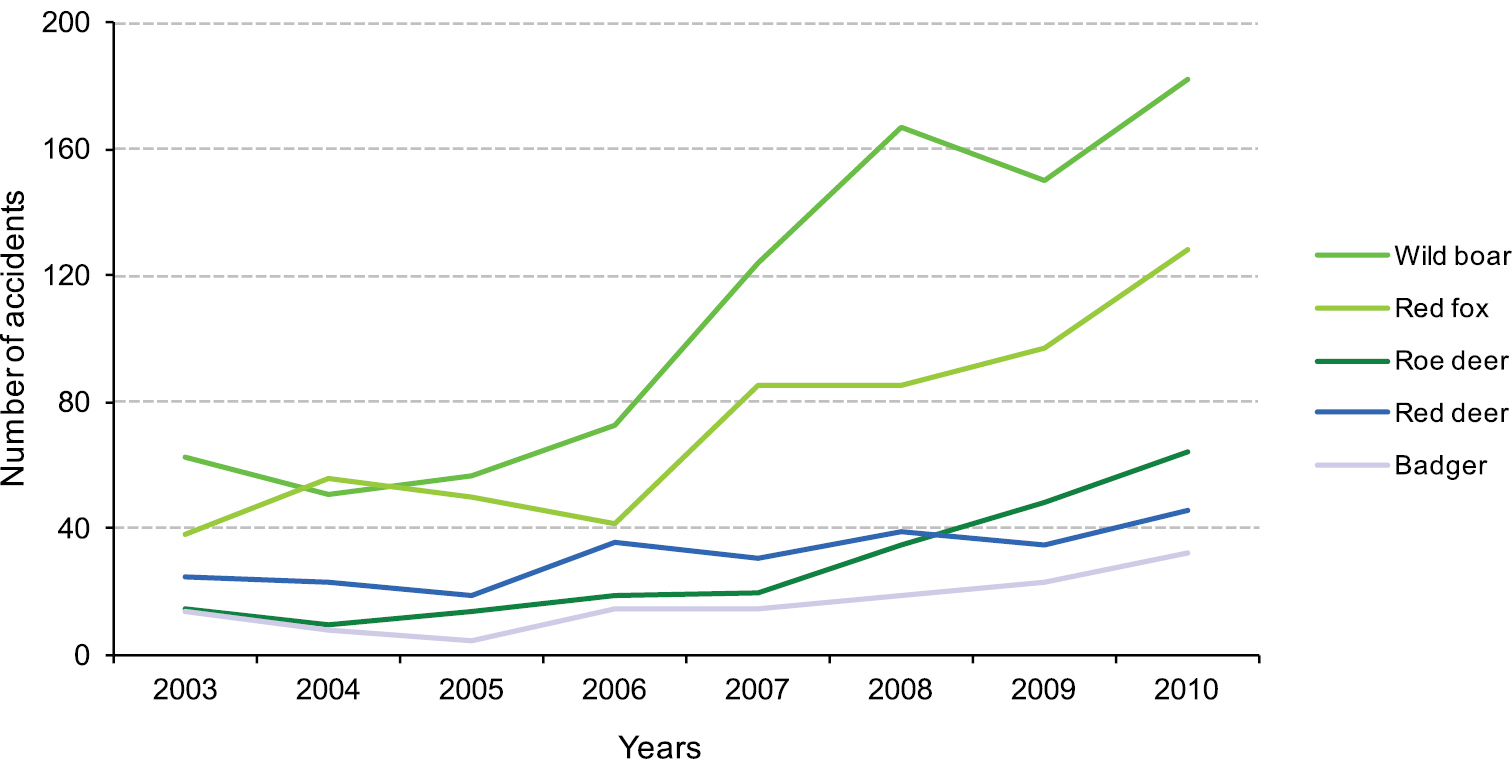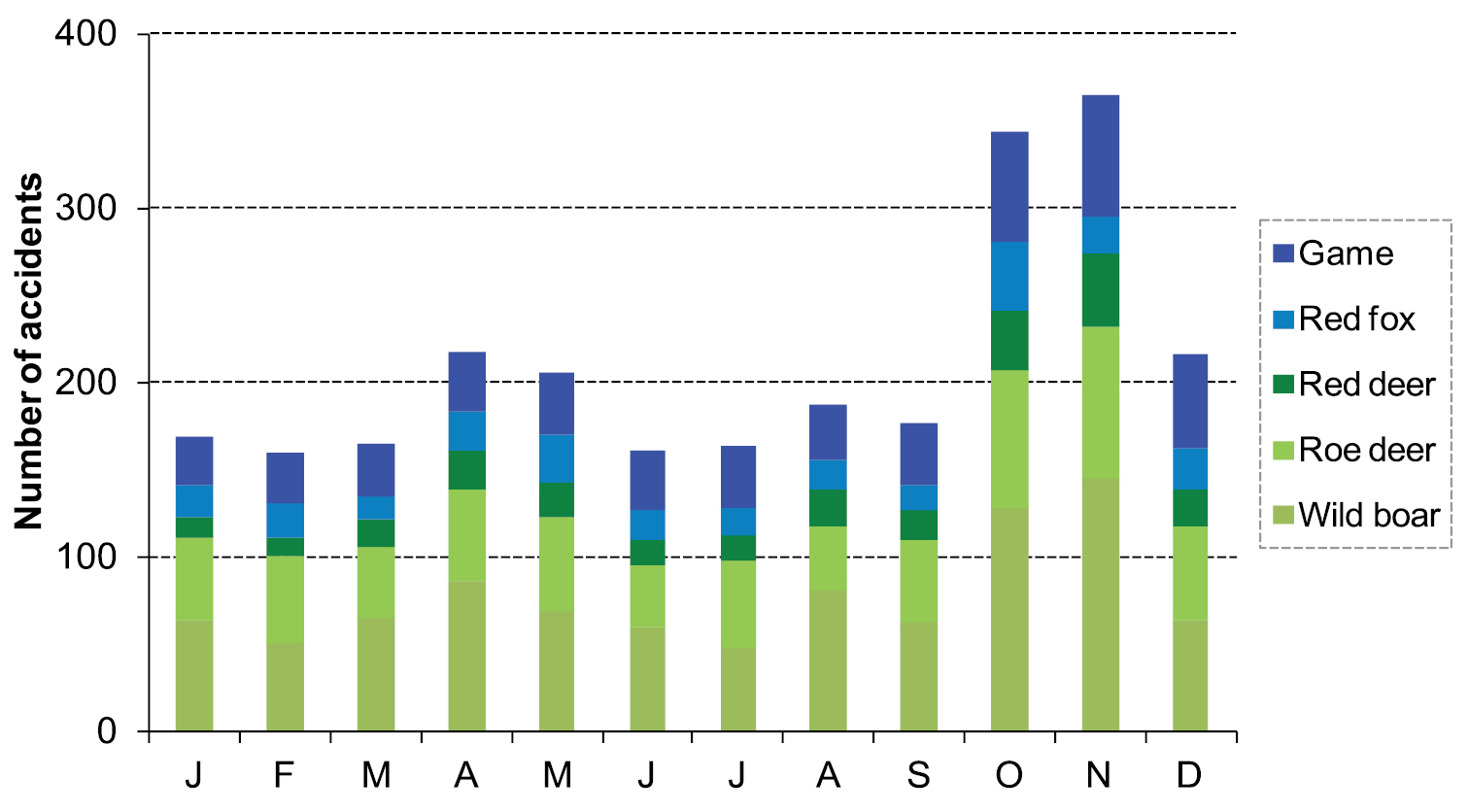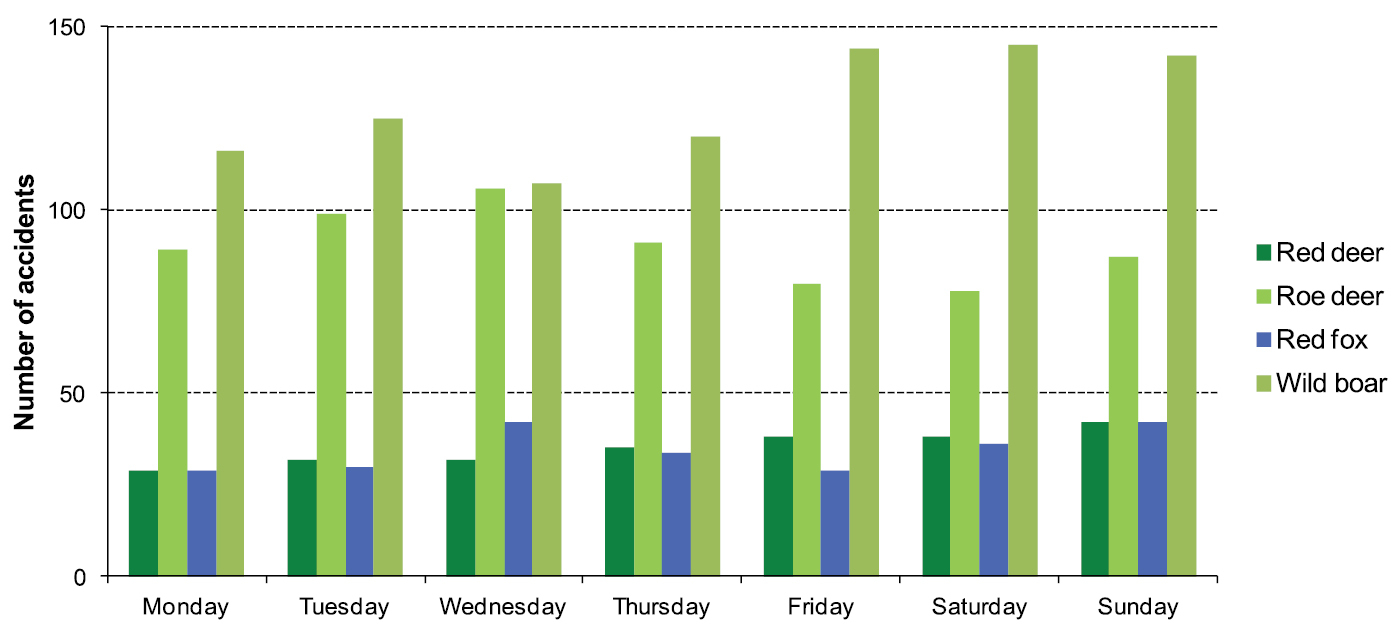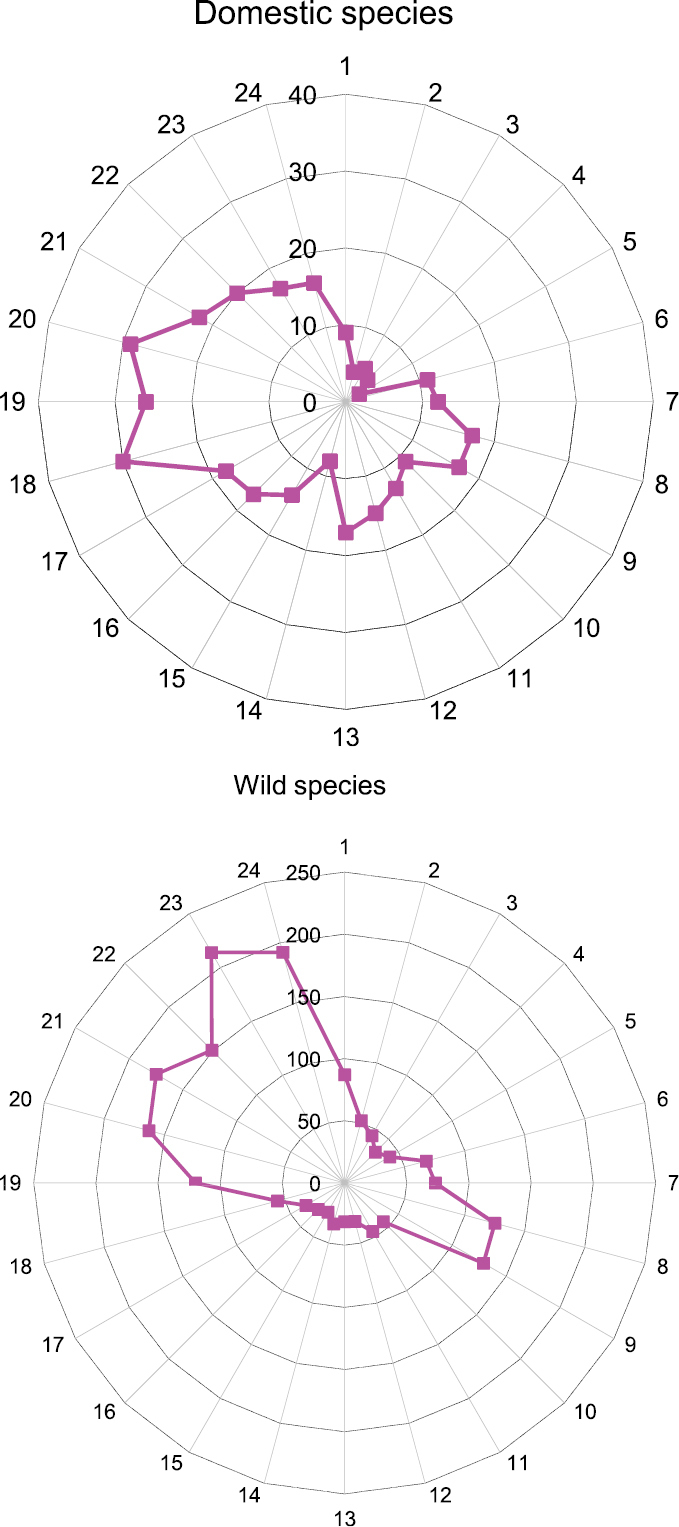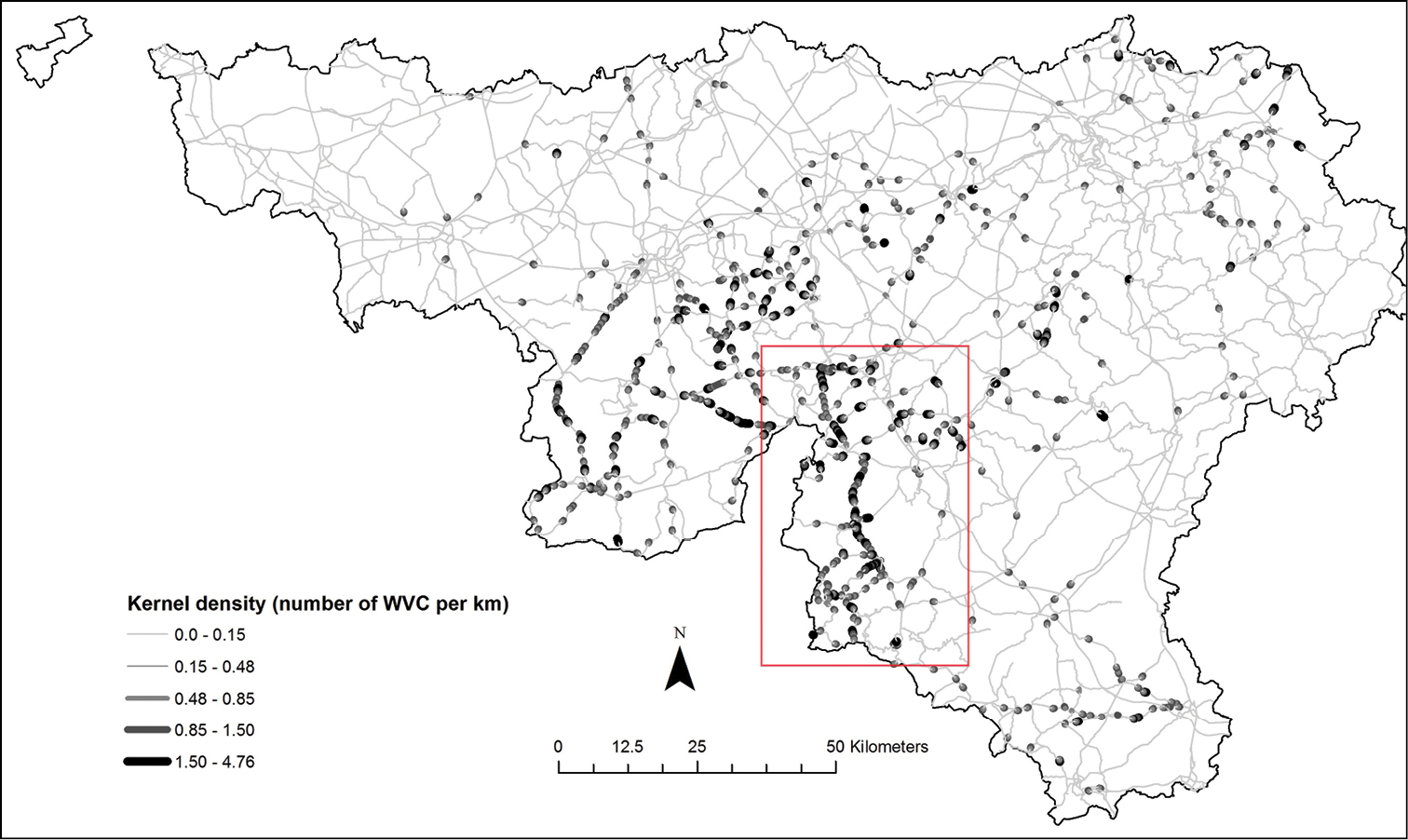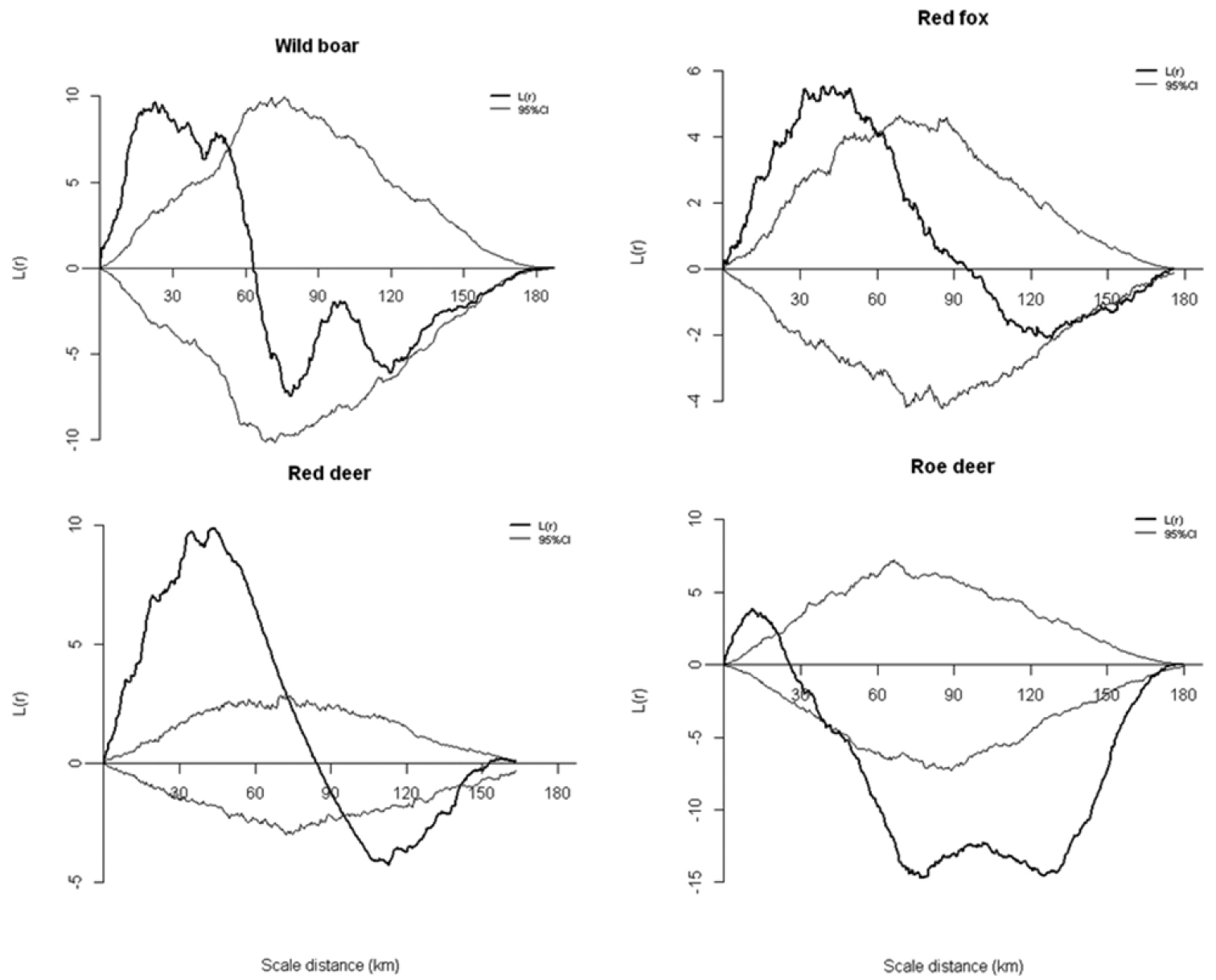






(C) 2013 Kevin Morelle. This is an open access article distributed under the terms of the Creative Commons Attribution License 3.0 (CC-BY), which permits unrestricted use, distribution, and reproduction in any medium, provided the original author and source are credited.
For reference, use of the paginated PDF or printed version of this article is recommended.
Citation: Morelle K, Lehaire F, Lejeune P (2013) Spatio-temporal patterns of wildlife-vehicle collisions in a region with a high-density road network. Nature Conservation 5: 53–73. doi: 10.3897/natureconservation.5.4634
This paper is the first to report data on wildlife-vehicle collisions (WVC) in Wallonia, southern Belgium, characterised by one of the densest road network worldwide. With the collaboration of police we identified 3965 accidents involving “free ranging animal” between 2003 and 2011. We observed that these accidents with free ranging animals result in 13% of cases in injuries for the drivers or passengers, and in less than 1% of cases in fatalities (death). 78% of these casualties involve wild animals, among which wild boar take the largest part (39% ). During the covered period we observed an annual increase of WVC of 21%. For wild boar and red deer, this increase was significantly correlated with hunting statistics, used as an index of population density. The temporal analysis demonstrated an increase of WVC during night time with peak of accidents at dusk and dawn. Monthly distribution revealed the role of breeding, dispersal and hunting in shaping temporal patterns of accidents. Spatial analysis, focusing on wild boar, roe deer, red deer and red fox demonstrated clustering of accidents for all these species, until scale between 20 to 70 km. Mapping of accidents via Kernel density analysis permitted us to highlight areas with high risk of WVC risk. Our study suggests that the problem of car accidents due to wildlife is an increasing concern in Wallonia but results on spatial and temporal patterns should help for setting up mitigation measures in the most sensible areas. Moreover we suggest that police data source should be used for nationwide analysis and for comparison between countries.
Wildlife-Vehicle Collisions (WVC), roads, spatio-temporal distribution, Wallonia
These last decades, simultaneous increase in infrastructure networks and ungulates populations (
To develop effective mitigation measures, knowledge about location and time of road casualties involving wildlife is required. It is important that every country undertakes road ecology researches because any situation is specific and can bring new relevant information on patterns of WVC. Moreover standardised data collection at national scale could help facilitating meta-analysis (
Literature about factors explaining wildlife-vehicle collisions is abundant, demonstrating the importance of this topic. During these last years many studies have brought up results on WVC for numerous countries, e.g. Spain (
However, in Wallonia, southern part of Belgium (Figure 1), no published data on accidents involving large species has been published so far. Contrary to Flanders (northern part of Belgium), Wallonia was not part of the COST 341-project ‘Habitat Fragmentation due to linear Transportation infrastructure’ (
South Belgian (Wallonia) and its road network within Europe and Belgium.
With its 4.8km/km2 of public roads, Southern Belgium (Wallonia) has one of the densest road networks of Western Europe combined to high human population density of 209 inhabitants per km2 (
OECD countries classified according to their roads and highways density (OECD Factbook 2008: Economic, Environmental and Social Statistics, SPF Mobility and Transport).
The aim of our research is toprovide the first results of spatial and temporal patterns of WVC for southern Belgium. In particular we analysed casualties regarding their specific composition (percentage of involved species), and for main game species (red deer Cervus elaphus, roe deer Capreolus capreolus, wild boar Sus scrofa and red fox Vulpes vulpes) causing most important social and economic damages, we analysed temporal (annually, monthly, daily and hourly) and spatial distribution patterns.
Our study area is the Walloon region, southern part of Belgium (50°30N, 4°45E, Figure 1). Climate is sub-oceanic temperate with a mean annual temperature of 8°C and a mean monthly temperature varying between 2 to 16°C. The mean annual rainfall is 900mm, and the mean annual length of snow cover is over 25 days. Roe deer, red deer and wild boar are the most abundant wild ungulates.
Data sources used to investigate accidents involving animals are manifold: insurance companies (
We investigated police database to search for traffic accident involving any domestic or wild animal species. Information’s on accidents resulting in injuries or fatalities were directly available from the central police database, while for accidents resulting in car damages each paper statement had to be checked out individually. In total, the collected data cover the period between 2003 and 2011, and consist of 3965 accidents. For each event we recorded date, time, species involved, and information about the location when available. From the 3965 accidents, 51% could be georeferenced by their milestone reference or by a detailed description of the location with an accuracy of 100m. Milestone references or detailed location were then exported into X Y value by using the corresponding value from the Wallonia road agency.
Exploratory analysis aimed at identifying species involved by calculating absolute and relative frequency of WVC occurrence for each category of species.Types of roads on which accidents occurred were also identified. For the temporal and spatial patterns analysis we only considered the following main game species: red and roe deer, wild boar and red fox. The reason for this choice is twofold. Firstly, they are the main species involved in WVC with social and economic consequences for which mitigation measures are required. Secondly, data available in police database contain only cases where at least car damages occur, preventing exhaustive information on WVC with small mammals to be analysed.
Temporal analysis focused on annual, monthly, weekly and daily distribution patterns of WVC. For each of these timescale, we looked for differences in roadkills relative frequency by using chi-square goodness-of-fit test (
For the spatial analysis we only consider accidents that occur along highways and national roads, due to the high complexity of the local road network and the relative low number of WVC compared to the total length of the road network. In total, we had thus a dataset composed of 840 casualties (Figure 3). Spatial pattern of WVC was assessed in three steps.
Distribution of WVC along highways and national roads.
In a first step, we used nearest neighbour distance (NND) to assess the distribution of animal-related casualties along the road network (
In a second step, we identified hot spot of collisions for each species by means of a kernel density analysis (
In a third step, we examined spatial structure of WVC at various spatial scales using the Ripley K function describing distribution patterns of points in space at different scales (
All the spatial analyses were performed with the use of the extension SANET® 4.1. Beta for ArcGIS 10 which provides tools adapted to perform spatial analysis along linear features (
In total 14 different species were identified: 5 domestic species representing 13% of accidents cases and 9 wild species representing 78% of accidents, the rest was undetermined species (Table 1). For the domestic species, dogs take the largest part of accidents with close to 10%, while wild boar and roe deer are together responsible of 45% of accidents with wild animals. 13% of accidents resulted in human injuries or death and the rest resulted in car damages. 7% of casualties occur on highways, 50% on national roads and 43% on regional or local roads.
Species involved in road accidents in Wallonia between 2003 and 2011.
| No human injuries | Human injuries | Total | ||||
|---|---|---|---|---|---|---|
| Number | Percentage | Number | Percentage | Number | Percentage | |
| Domestic species | ||||||
| Dog | 262 | 6.61 | 120 | 3.03 | 382 | 9.63 |
| Horse | 24 | 0.61 | 24 | 0.61 | 48 | 1.21 |
| Cow | 28 | 0.71 | 19 | 0.48 | 47 | 1.19 |
| Cat | 26 | 0.66 | 11 | 0.28 | 37 | 0.93 |
| Pig | 0 | 0.00 | 1 | 0.03 | 1 | 0.03 |
| Total domestic species | 340 | 8.58 | 175 | 4.41 | 515 | 12.99 |
| Wild species | ||||||
| Wild boar | 975 | 24.59 | 81 | 2.04 | 1056 | 26.63 |
| Roe deer | 682 | 17.20 | 30 | 0.76 | 712 | 17.96 |
| Fox | 279 | 7.04 | 14 | 0.35 | 293 | 7.39 |
| Red deer | 244 | 6.15 | 28 | 0.71 | 272 | 6.86 |
| Badger | 147 | 3.71 | 5 | 0.13 | 152 | 3.83 |
| Pheasant | 89 | 2.24 | 2 | 0.05 | 91 | 2.30 |
| Hare | 59 | 1.49 | 1 | 0.03 | 60 | 1.51 |
| Bird | 53 | 1.34 | 4 | 0.10 | 57 | 1.44 |
| Rabbit | 15 | 0.38 | 0 | 0.00 | 15 | 0.38 |
| Fallow deer | 6 | 0.15 | 1 | 0.03 | 7 | 0.18 |
| Bighorn | 4 | 0.10 | 2 | 0.05 | 6 | 0.15 |
| Weasel | 2 | 0.05 | 0 | 0.00 | 2 | 0.05 |
| Red squirrel | 1 | 0.03 | 0 | 0.00 | 1 | 0.03 |
| Raccoon | 1 | 0.03 | 0 | 0.00 | 1 | 0.03 |
| Unspecified ungulates | 361 | 9.10 | 24 | 0.61 | 385 | 9.71 |
| Total wild species | 2557 | 64.49 | 192 | 4.84 | 3110 | 78.44 |
| Undetermined | 199 | 5.02 | 141 | 3.56 | 340 | 8.58 |
| Total | 3457 | 87.19 | 508 | 12.81 | 3965 | 100.00 |
WVC increased by 117% during the study period. Specifically roadkills increased by 50% for badger, by 193% for red deer, 242% for roe deer, 194% for wild boar and 52% for red fox (Figure 4). Abundance indexes coming from hunting bag records (annual number of shot animal) were highly (0.89 for wild boar and 0.67 for red deer) to poorly (-0.07 for roe deer) related to number of accidents.
Annual variation of the number of accidents involving badger, red fox, roe deer, red deer and wild boar.
All the game species investigated showed not uniform monthly distribution of accidents (Figure 5). Casualties with red deer (χ2 = 41.6, df = 11, p < 0.001) increase in April-May and then from September to November. For roe deer (χ2 = 70.4, df = 11, p < 0.001) accidents peak also in April-May and then in October-November. Wild boar (χ2 = 456.9, df = 11, p < 0.001) have their maximum from October to December, while red fox (χ2 = 32.6, df = 11, p < 0.001) accidents are more evenly distributed with peaks in January, May and October-November.
Monthly distribution of road casualties for red fox, red deer, roe deer, wild boar, and others undetermined game species.
Although we could visually observe an increase in the number of accident occurrences during weekend for wild boar, we did not observe significant differences with other days of the week (Figure 6).
Daily distribution of road casualties for red fox, red deer, roe deer and wild boar.
Hourly distribution for both wild (χ2 = 959.2, df = 23, p < 0.001) and domestic (χ2 = 87.2, df = 23, p < 0.001) species was not uniformly distributed. WVC show tendency towards night and morning distribution while collisions with domestic species are more evenly distributed during daytime with peak between 5 and 7 pm (Figure 7).
Hourly distribution patterns of road accidents for wild and domestic species.
We observed that all game species were not randomly distributed along highways and national road network (Table 2, nearest neighbour distance and Clark-Evans index).
Results of the spatial distribution patterns analysis with the Clark-Evans index (value > 1 for aggregated distribution) and P-value for Nearest Neighbour Distance analysis.
| Species | n | Clark-Evans index | CRS (NND) |
|---|---|---|---|
| All | 840 | 0.52 | p < 0.05 |
| Red deer | 56 | 0.41 | p < 0.05 |
| Roe deer | 260 | 0.63 | p < 0.05 |
| Wild boar | 421 | 0.46 | p < 0.05 |
| Red fox | 103 | 0.51 | p < 0.05 |
Kernel density analysis revealed heterogeneous distribution WVC along the road network (Figure 8). Concentration of accidents for all species is observed in the centre-south of Wallonia.
Kernel density estimation for WVC considering all species across the whole area and study period (2003–2011). Bandwidth used was 500m and cell size was 50m. In red, the delimited area concentrating high risk areas where the spatial structure analysis (K and L-function) was performed.
For all the species but roe deer, distribution of roadkills followed the same patterns, with significant clustering at scale ranging from one to more than fifty kilometres (Figure 9). While wild boar and red fox accidents become randomly distributed at large scale (> 60 km), red and roe deer accidents, quickly switch from a clustered to a dispersed distribution. For roe deer, clustering of accidents occurred until a scale of twenty kilometres and at scale higher than forty kilometres distribution becomes dispersed (Figure 9).
Plot of the L-statistic as a function of scale for distribution of the four main game species roadkills on the selected area of Wallonia. Solid lines represent the observed number of neighbors per roadkill event along the road minus the expected number of neighbors if the roadkills were randomly distributed. Roadkills are significantly clustered (P < 0.05), dispersed or randomly distributed at scale r when, respectively, L(r) is above, under or within the 95% confidence interval.
We observed that 87% of accidents with animals result in car damages, which is in accordance with a study by
In Sweden wildlife-related accidents is suspected to cause an average annual loss of 1–12% of the estimated population of common mammal species (
During the study period, the number of WVC has increased constantly and sharply for most of the species, particularly for wild boar and red deer. This annual increases seems to be related topopulation increase if we assume hunting statistics and number of car accidents reflect well animal population size (
Monthly distribution of WVC demonstrated effects of breeding, dispersal and external factors on increase of movement and consecutively on risk of accidents. Theseresults are in accordance with
Peak of accident events at dusk and night reflects the nocturnal behaviour of mammals living in human-disturbed areas, forcing them to switch most of their foraging activities during night when risk of being seen or disturbed by human is lowered (
Although national and highways account for 14.6% of the total length of the road network in Wallonia, we observed that more than a half of the WVC occur on these roads. This disproportionate number of accidents on major roads is in accordance with results reviewed in
Spatial analyses of accidents showed that for all species, the distribution along the road network was not random. We indeed observed that WVC were highly clustered along highways and national roads in Wallonia, Southern Belgium. Spatial structure demonstrated a clustered patterns, also observed for roe deer in Denmark (
We decided to concentrate our effort for analyzing spatial structure at various scales by means of the Ripley K and the L-function on a smaller size area because when including the whole network we observed clustering patterns at all scales because the number of WVC was too low regarding the total length of the road network (
Kernel density mapping showed areas with higher risk of WVC. Road density and land cover are likely to explain this non-random pattern (
The Wallonian road network is almost completely developed since decades now. Implementing wildlife passage on already built highways is more expensive than when it is included from the beginning in road construction plan. However mitigation measures should locally be set up in most risky areas to decrease the number of casualties. Indeed, as we have seen, accidents with wild mammals show strong temporal and spatial patterns, and the peaks identified could help to set up measures that increase the awareness of drivers during more sensible period of the year or the day. Informative signs on potential animal crossing along the road have been demonstrated to increase the alertness of drivers (
Next to roadkills, road network have others negative effects on large mammals. They can indeed act as barriers for animal movement, subdividing species into subpopulation, although this might depend of the effect of the road type and the species. Hence, in Belgium a recent study by
Our study is the first to bring results in Wallonia about WVC. We brought insights into species involved and in the spatio-temporal patterns of these accidents. Wild boar and roe deer constitute the major part of the accidents. Temporal analysis showed the role of animal biology in explaining monthly and daily patterns of WVC occurrences. Multi-scale spatial analysis demonstrated the clustering patterns of accidents in Wallonia for the main game species. These results highlight the need to take both spatial and temporal components into account for building predictive model. The next step of our research will indeed be dedicated to joining the results of this research together with landscape and road factors to build a predictive model of WVC hotspots and to propose mitigation strategies that could enhance both human and animal safety. GPS data collected on wild boar and red deer will be used to determine the road effect for these two species behaviour. This will bring us new understanding on the real effect of road network on animal behaviour. However many WVC are still not reported, because of the absence of police statement, but would be required to measure more precisely long–term effects of roads on main game species. We thus hope these first results will be helpful in convincing stakeholders (police, local authorities, insurance companies, forest administration, naturalists, drivers) to collaborate so that better data collection could be achieved in the near future.
This research was partially supported by the Fonds pour la Formation à la Recherche dans l’Industrie et l’Agronomie (FNRS-FRIA, Belgium). We are grateful to the different Court of Justice that authorized us to access the statements involving free-ranging animals. We also would like to thank Belgian Federal Police and every Local Police Zone for their participation in the collection of the data. Thanks to Coralie Mengal for the management of the database. We also wish to thank two anonymous native speakers for improving the English grammar of the text.
